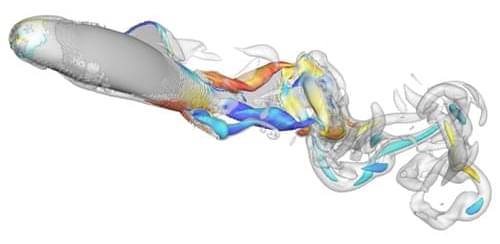As fish wriggle, they create a complex push–pull pattern in the water that propels them forward. Many studies have shown how the motion of a fish’s tail forms a vortex around its leading edge that provides thrust; however, it has been difficult to capture how the water flow around other parts of the fish interacts with this vortex to impact the overall propulsion. Jiacheng Guo at the University of Virginia and colleagues recently demonstrated how different fins create currents that can constructively interact to improve swimming efficiency [1].
Guo and colleagues studied how the flow around the lower back—or anal—fin interacts with the flow around the tail—or caudal—fin. First, they took a high-resolution video of a swimming rainbow trout and created a computational fluid dynamics model to accurately reproduce the fish’s motion and the water currents that it induced. Then they modified the anal fin in the model to see how this would change the pattern of water flow around the trout and affect the forward thrust.
The researchers found that the anal fin increases propulsion in two ways. It creates a vortex that stabilizes and strengthens the caudal-fin vortex, and it helps maintain a pressure difference across the fish’s body that reduces drag. Changes to the size or position of the anal fin decreased the swimming efficiency, demonstrating that the natural fish physiology is optimal.
